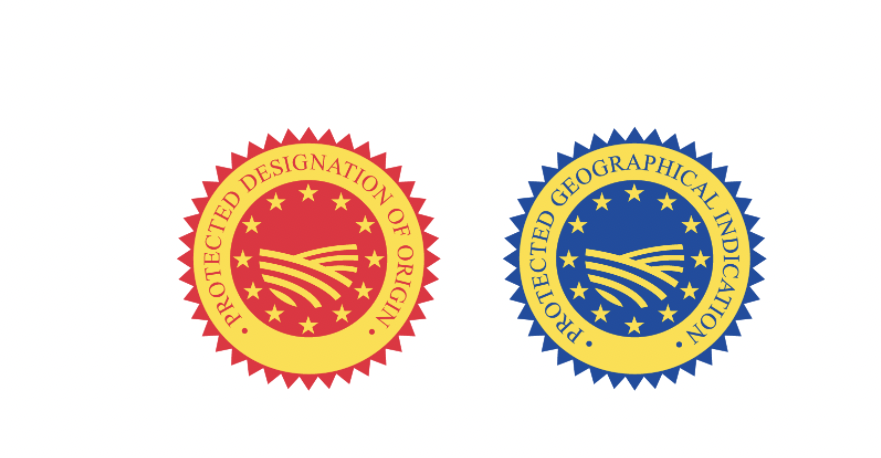“It does not seem ‘right’ that ‘Collective PDO/PGI Trademarks’ must be treated, with respect to distinctiveness, the same as individual marks… The purpose of individual trademarks and ‘Collective PDO/PGI Trademarks’ is the same, to be sure…but the fabric from which they are made is not.”
Under European Union (EU) law—specifically, Article 103(2) of Regulation 1308/2013—signs that qualify as protected designations of origin (PDOs) or protected geographical indications (PGIs) are shielded against any direct or indirect commercial use, as well as against any “evocation” of it that is likely to mislead a consumer as to the true origin of the product. This language raises the question of the conditions under which a sign may be said to be “evocative” of a PDO or PGI.
The CHAMPANILLO Case
On September 9, 2021, the Court of Justice of the European Union (CJEU) issued a ruling — C 783/19 — in response to a request for a preliminary ruling concerning the (individual) trademark CHAMPANILLO. I refer here to the French text of the decision since, to my knowledge, an English version has not yet been published.
The sign in question was used in Spain by Mr. “GB” to identify his catering services. In response, the French Comité Interprofessionnel du Vin de Champagne (CIVC), a semi-public organization responsible under French law for safeguarding the interests of champagne producers, brought an action before the Juzgado Mercantil de Barcelona (Commercial Court of Barcelona, Spain). The CIVC’s claim was that the sign CHAMPANILLO infringed on the internationally renowned sign “Champagne,” protected in Europe as a PDO pursuant to the aforementioned Regulation no.1308/2013.
The Commercial Court rejected the CIVC’s claims. It held that “Champanillo” did not constitute an evocation of “Champagne” because it was being used in relation, not to a product (i.e., wine or other beverage), but to a service. Further, the exercise of the service did not involve the sale of champagne wine.
The CIVC appealed to the Audiencia Provincial de Barcelona (Provincial Court of Barcelona, Spain), which decided to stay the proceeding and, in a nutshell, asked the CJEU to establish a criterion or criteria according to which a sign can be said to evoke a PDO or PGI unlawfully, according to the meaning of the regulation.
The CJEU ruled:
[…] L’article 103, paragraphe 2, sous b), du règlement no 1308/2013 doit être interprété en ce sens que l’« évocation » visée à cette disposition, […] est établie lorsque l’usage d’une dénomination produit, dans l’esprit d’un consommateur européen moyen […] un lien suffisamment direct et univoque entre cette dénomination et l’AOP. (emphasis added)
In other words, a PDO/PGI is evoked whenever a disputed designation triggers directly in the mind of consumers the product for which the geographical indication is protected (see the Advocate General’s Opinion in Champanillo, point n. 51, here).
Trademarks with Reputation
This lien (“link”) that must exist between the PDO/PGI and a later sign in the mind of the public in order for a court of law to ascertain that an unlawful evocation has occurred (the “Link”) seems to be the same conceptual connection (that has its origin in the dilution doctrine) that the CJEU has envisaged since Adidas v Fitnessworld (C-408/01) across the distinct but contiguous subject matter of trademarks with a reputation (known in other jurisdictions as “well-known,” “famous” or “highly-renowned” trademarks), according to Article 5(2) of Directive 89/104/EEC (now Article 10 of Directive 2015/2436). In the latter case, the CJEU held that:
The infringements referred to in Article 5(2) of the Directive, where they occur, are the consequence of a certain degree of similarity between the mark and the sign, by virtue of which the relevant section of the public makes a connection between the sign and the mark, that is to say, establishes a link between them […]. (emphasis added).
Therefore, one criterion for determining whether evocation of a PDO as referred to in Article 103(2) of Regulation no. 1308/2013 has occurred seems to be the same as the criterion for determining whether a trademark with a reputation has been infringed, namely, the possible existence of the Link.
Extending the ‘Link’
This raises the question of whether it is possible to establish such a Link with regard to collective trademarks consisting of PDO/PGI as well. I refer in particular to the CJEU’s well-known Halloumi v BBQLOUMI decision (C-766/18). “Halloumi” is a PDO designating a specific kind of cheese produced in Cyprus (here) and is held as a collective trademark by the Foundation for the Protection of the Traditional Cheese of Cyprus. In this case, the CJEU ruled (among other things) that the collective trademark “Halloumi” had weak distinctiveness for a large part of the relevant public, since that public would understand it as a possible reference to Halloumi cheese (see point 75 of the Halloumi case).
However, the Court’s conclusion in this regard represents a sort of paradox, as Dav Gangjee pointed out (though the wording is mine). In light of the CJEU’s Halloumi decision, a collective trademark consisting of a combined PDO/PGI will always be considered weak because of its ontological descriptive elements, which is to say, the denomination of origin or geographical indication that is, indeed, inherently descriptive of goods and their sources.
Differential Distinctiveness
This is, arguably, not a satisfactory outcome. The CJEU’s statement that none of the characteristics of EU collective marks justified derogation from the assessment criteria set forth for the individual trademarks regarding the likelihood of confusion (see, e.g. point 66 of the Halloumi decision, confirming its findings in the Darjeeling case, specifically point 44), it seems to me, could be deemed reasonable with regard to collective trademarks in general. On the other hand, though, it could be argued that such a derogation may be justified for a “Collective PDO/PGI Trademark” because of the distinctive character of the PDO/PGI that forms the collective trademark, which should be taken into account when assessing the likelihood of confusion. This distinctive character resides in “differential distinctiveness,” that is, the uniqueness of one sign when compared with others, as opposed to mere “source distinctiveness” (a distinction proposed by Barton Beebe), that is, the uniqueness of the message that a sign conveys (i.e., the particular quality of the product linked to its geographical source (mileu)) notwithstanding its descriptive nature (or precisely because of it).
Now, with respect to mitigating the outcome that has garnered criticism (i.e., that “Collective PDO/PGI Trademarks” will always be assessed as weak), my fascination with this issue is the possibility that the Link applies to conflicts between an individual trademark and a “Collective PDO/PGI Trademark”. The aim in this regard would be to reveal the differential distinctiveness of the latter. To do so, the PDO and PGI that form the collective trademark should be thought of as a “trigger” for the broad application of Article 103(2); in other words, as constituting a “door” through which the Link may be taken into consideration in assessing the likelihood of confusion between an individual trademark and a “Collective PDO/PGI Trademark”. Notably, however, in this scenario, the rules governing the PDO/PGI would not override the rules governing individual marks; rather, the former would only serve to offset the latter with regard to the distinctiveness of the sign.
Collective PDO/PGI Marks Should be Distinguished
It can easily be argued that this kind of interpretation would be contra legem or just plain “wrong” from a systematic point of view. Still, my fascination persists owing to the perception that it does not seem “right” that “Collective PDO/PGI Trademarks” must be treated, with respect to distinctiveness, the same as individual marks (as the CJEU held in the Halloumi and Darjeeling cases). The purpose of individual trademarks and “Collective PDO/PGI Trademarks” is the same, to be sure, namely, to distinguish the commercial origin of a product or service, but the fabric from which they are made is not. On the other hand, the Link itself originated, through the CJEU’s interpretation, precisely in the field of law (i.e., relating to individual trademarks), in which distinctiveness—understood as “source of origin”—was, once (but not any longer), the only beacon suggesting the way when assessing the likelihood of confusion.

![[IPWatchdog Logo]](https://ipwatchdog.com/wp-content/themes/IPWatchdog%20-%202023/assets/images/temp/logo-small@2x.png)


![[Advertisement]](https://ipwatchdog.com/wp-content/uploads/2024/04/Patent-Litigation-Masters-2024-sidebar-early-bird-ends-Apr-21-last-chance-700x500-1.jpg)

![[Advertisement]](https://ipwatchdog.com/wp-content/uploads/2021/12/WEBINAR-336-x-280-px.png)
![[Advertisement]](https://ipwatchdog.com/wp-content/uploads/2021/12/2021-Patent-Practice-on-Demand-recorded-Feb-2021-336-x-280.jpg)
![[Advertisement]](https://ipwatchdog.com/wp-content/uploads/2021/12/Ad-4-The-Invent-Patent-System™.png)







Join the Discussion
No comments yet.